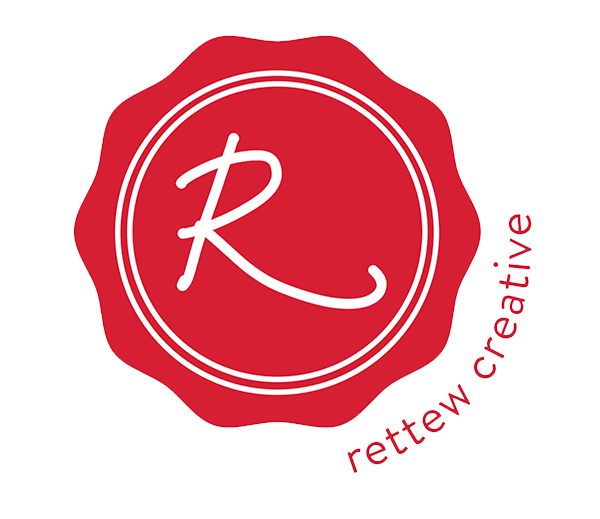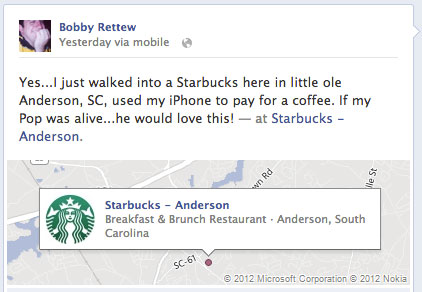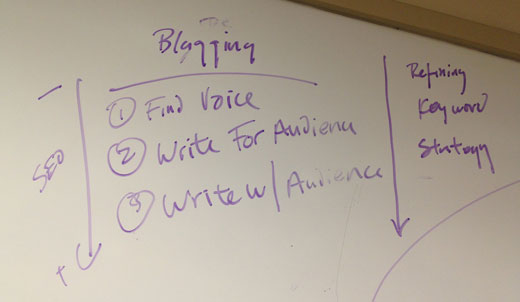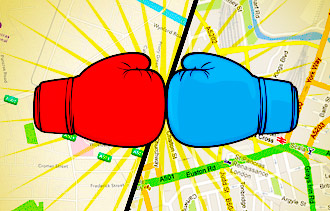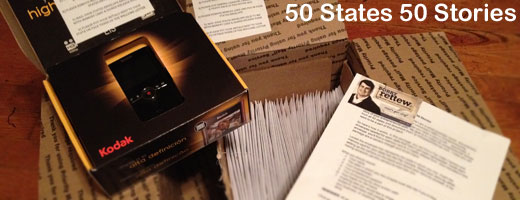So Wednesday morning, I received my new iPhone 5 in the mail. I am a gadget freak and yes I upgraded from the iPhone 4s. One of the new features released with the new iPhone (iOS6) is the the Passbook application. This allows you to find businesses that offer incentives to use your iPhone as your wallet.
So I downloaded the Starbucks application and immediately created an account and loaded $25.00, sort of like buying a pre-paid credit card, except using your iPhone. Off I went to carry out my morning errands, and as I passed Starbucks in Anderson…I thought I might have to give this little application a try.
So I walked in and ordered me a Pumpkin Spice Latte with no whipped cream, hmm! It feels like fall outside. When it was time to pay, I asked the cashier, “How do I use the Starbucks application on my iPhone to pay?” She told me to open the application, push the button to pay, and a barcode appeared on the screen. She then used her scanner next to the cash register to scan the barcode on my screen, and POOF…transaction complete.
It deducted the $4.91 from my phone and off I was on my merry way with a Pumpkin Spice Latte. I was so excited, I opened Facebook and checked into Starbucks by writing this status update:
I immediately called my wife to share my experience. After she listened to my gadget success story for the morning, she scolded me and said…”You need to buy local. Stop going to Starbucks and walk across the street from your office downtown and go to Figs. Figs is the new coffee, ice-cream, soda shop downtown Anderson owned locally.
The Digital Divide
Hmm…I wonder, do they have a little application for the phone so I can pay? Do they have a check-in option on Facebook so I can share my love for their store? Hmm…let me go see. So off I went to Figs, and noticed a few things. Great food, great shop, nice ownership…limited social interaction. Well, they are new…but this leads me to my though process. Buying local in socially connected community has a HUGE barrier to cross when competing against big box groups. You are probably thinking…well, tell me something you do not already know.
Ok, back-up…notice what happened Starbucks. They have an app that allows me to use technology to not only purchase with my phone, but they made it easy to take part in the social share. The check-in location rapidly appeared in Facebook allowing me to share my little success with technology.
The digital wallet leading to the social share…big business leads the way in social commerce. So how do the little guys compete? What is going remind me about Figs over Starbucks for coffee (other than my wife screaming buy local)? Figs is kind-of a outlier, they have only been in business for a few months. They are still trying to establish their digital footprint.
So, I took a walk through downtown Anderson and spent some time using my Facebook and Foursquare apps to see if retailers had check-in points established. Most were established including having those check-in points connected to a social outlet like a Facebook page.
But the part that is missing for most of these small retailers is the digital tool for commerce.
Passbook and NFC
Passbook on the iPhone is a brand new concept and Starbucks was one of the first to take part in this concept. Passbook was Apple’s alternative to NFC (near-field communication).
Wired.com states, “NFC chips in smartphones let you pay by waving your device over a scanner at the store. The chip is tied to an app that is tied to your bank account and credit card. Volià, no more cash, no more wallet.”
“Passbook lets you keep in your iPhone virtual versions of some items you might normally carry in your analog wallet or bag: boarding passes, movie and sports tickets, coupons, and gift cards. Passbook stores these items as barcodes, but some wondered if Apple would tie NFC to Passbook to make direct payments possible.”
Matt on the Nerd Wallet blog shares his thoughts:
“While loyalty programs are popular amongst customers and merchants alike – the number of loyalty memberships in the U.S. exceeds 2.1 billion – it’s not clear how effective these programs are. According to a white paper published by COLLOQUY, 17% of U.S. consumers felt that loyalty programs were a “very influential” factor in their purchasing decisions and an even smaller 12% said they “strongly agree” when asked whether it pays to be loyal to a favorite brand.”
So is NFC and Passbook just another coupon”ing” option or loyalty program? Or is the combination of NFC/Passbook concept on your smart phone as a one-stop shop for your to purchase and share with your friends. Connivence makes us happy and we love to share within our social outlets when something makes us happy.
Social Commerce & Economic Development
So how does a small coffee shop in little ole Anderson, SC compete with a Starbucks and their Passbook app? Well…first of all, building these applications are expensive and you have to find a a company that has the experience to build these types of mobile commerce tools. I am not sure if Figs would have the budget to have one of these applications built, and it probably makes no sense for them to do so…especially given small town word-of-mouth always prevails.
BUT…from a digital concept, local business should team up and build one mobile application for those local retailers that can add to the pot. Imagine an initiative in Anderson, SC where a group of local retailers teamed up with the Chamber of Commerce and local Economic Development groups like Innovate Anderson or Upstate SC Alliance to find the funding to build a one-size fits all.
Yes…this would be an economic development tool for small town Anderson, SC. Access to digital tools that not only power commerce but power the idea of the social share, building online reputation for a town trying to attract more growing businesses.
For those who want to read more about developing apps for Apple’s Passbook –> CLICK HERE.
